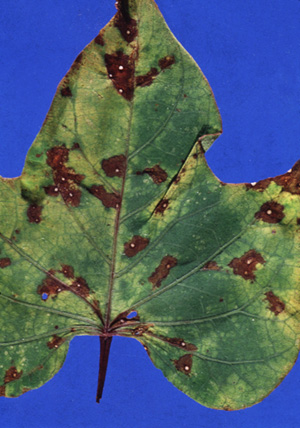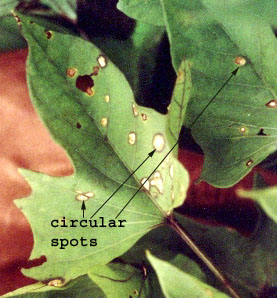| Kingdom |
Fungi |
| Phylum |
‘mitosporic fungi’ |
| Class |
Hyphomycetes |
No references have been found on the economic importance of this disease.
The disease is commonly found throughout the tropics, mainly in the Caribbean
and South and Central America such as in Antigua y Barbuda, Cuba, Dominican
Republic, Costa Rica, French West Indies, Guyana, Panama, Peru, Puerto Rico
and Venezuela. It has also been noted in India, Japan, Italia,
Netherlands, Antilles and USA.
The conidiophores form loose
synnemata. They are olivaceous
brown, smooth, up to 150 µm long, 2-3 µm thick at the base, and 5-7 µm near
the apex. The conidia are
cylindrical to obclavate, conico-truncate at the base, pale olivaceous brown,
with 4 - 8 septate, are 55-120 µm long
and 4-8 µm thick in the broadest part.
Light green spots, approximately 0.5 mm in diameter, initially appear on
both surfaces of the leaf. These lesions gradually increase in size and
turn brown, with yellow green border advancing at the periphery of the
lesion. About two weeks after the first appearance of the symptoms, the
lesions further increase to about 3-4 mm in diameter. Two different zones are
observed: the centre which is pale brown to whitish grey and the border which is
brown to purple black (see figures). Although the veins limit the lesions, those
which are close to each other coalesce and form blighted
areas on the leaf. Severely blighted leaves turn yellow leading to
defoliation. These symptoms can be found on leaves of different ages
throughout the plant, although more spots are found on older leaves.
Fruiting structures of the fungus, consisting of dark conidiophores
bearing conidia, can be observed at the centre of the spots, especially after
rainfall.
Differences in size, shape and colour of the spots are found. This may be due
to the presence of other species of Cercospora attacking sweetpotato such
as C. timorensis, and C. batatae.
The disease is dispersed by wind or splashing rain. It is most prevalent in
the hot and humid tropics and is seldom observed during the dry season.
The primary host of C. bataticola is Ipomoea batatas (sweetpotato).
Although no other hosts have been reported it is suggested that this
pathogen can overwinter on some weed species.
The peculiar appearance of the spots with very sharp differences between the
centre and the border is one way to recognize the disease in the field.
Another way of identifying the disease is to observe the fruiting
structures under a compound microscope. For this, it is advisable to collect the
samples from the field, early in the morning and to scrape the surface of the
spot to observe the conidiophores and conidia.
Cultural control
No control measures are known. Control is not usually needed. However, it is
suggested that only healthy material should be used for planting.
Host - pathogen resistance
Differences in susceptibility have been found, but these differences could be
due to the presence of other Cercospora species.
Ellis, M.B. 1976. More Dematiaceous Hyphomycetes. Commonwealth Mycological
Institute. Surrey, England, 507 p.
Chupp, C. 1954. A monograph of the fungus genus Cercospora. Ithaca,
New York; published by the author, 667 p.
De la Cruz, C.S., Loreto, F.L. and
Palomar, M.K. 1981. Effect of brown leaf spot disease on the growth and yield of
sweet potato. Ann. Trop. Res. 3:206-213.
Contributed by: Teresa
Ames |
Taxonomy
Economic
importance
Geographical
distribution
Morphology
Symptoms
Biology
and ecology
Host
range
Diagnosis
Management
References

Leaf
lesions with light centres and dark margins (D.
Gamarra).

Circular
spots with whitish centre and brown margin (E. Rasco, Jr.).

Characteristic
spotting on leaves (T. Ames). |

